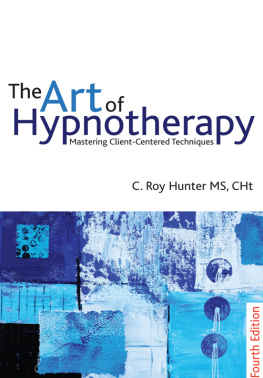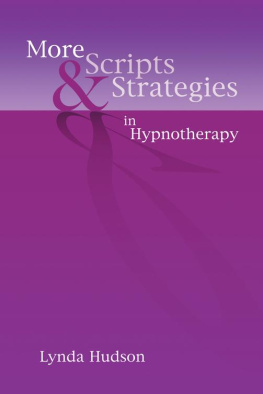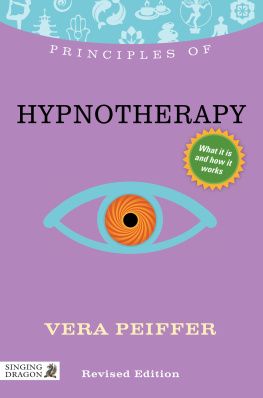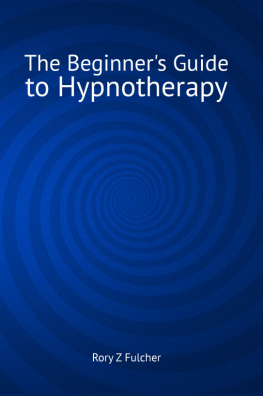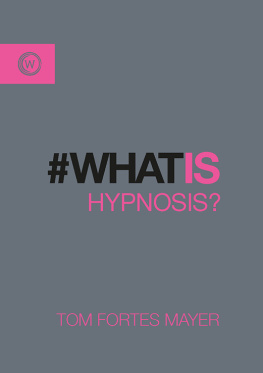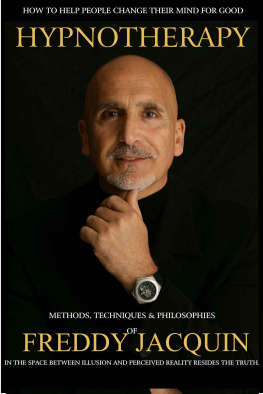The Art of
Hypnotherapy
Fourth Edition
Part II of Diversified Client-Centered Hypnosis
(based on the teachings of Charles Tebbetts)
C. Roy Hunter, M.S., FAPHP

Crown House Publishing Limited
www.crownhouse.co.uk
www.crownhousepublishing.com
First published by
Crown House Publishing Ltd
Crown Buildings, Bancyfelin, Carmarthen, Wales, SA33 5ND, UK
www.crownhouse.co.uk
and
Crown House Publishing Company LLC
6 Trowbridge Drive, Suite 5, Bethel, CT 06801, USA
www.crownhousepublishing.com
C. Roy Hunter 1995, 2000, 2007, 2010
The right of C. Roy Hunter to be identified as the author of this work has been
asserted by him in accordance with the Copyright, Designs and Patents Act 1988.
All rights reserved. Except as permitted under current legislation no part of
this work may be photocopied, stored in a retrieval system, published, performed
in public, adapted, broadcast, transmitted, recorded or reproduced in any form or
by any means, without the prior permission of the copyright owners.
Enquiries should be addressed to Crown House Publishing Limited.
British Library of Cataloguing-in-Publication Data
A catalogue entry for this book is available
from the British Library.
10-digit ISBN 184590440-0
13-digit ISBN 978-184590440-1
eBook ISBN 978-184590452-4
LCCN 2010921871
Third edition published by Kendall/Hunt Publishing Company
under ISBN: 978175754174
Printed and bound in the USA
Dedication and Acknowledgements
This second volume of Diversified Client-Centered Hypnosis, like the first volume (The Art of Hypnosis), is dedicated to all those who believe in the benefits of client-centered hypnosis to facilitate positive changes for willing clients.
We all owe a debt of gratitude to Charles Tebbetts for his tireless dedication to the art of hypnotism, evidenced by his many years of teaching and practicing. He based his hypnotherapy course on what he learned from Gil Boyne, who also deserves thanks for creating and promoting an in-depth hypnotherapy training course.
Additional gratitude is in order for Charlies wife, Joyce Tebbetts, who worked behind the scenes for so many years to support her husbands important work. Certainly her efforts helped a great deal in promoting competent hypnotherapy training.
While Charlie was living, I expressed my appreciation to both Mr. and Mrs. Tebbetts for their support in my teaching The Charles Tebbetts Hypnotism Training Course. Before her passing in 2004, Joyce continued that support by putting her blessing on the first edition of this book, for which I am grateful. Her preface, written for the first edition, remains. This fourth edition, completed in 2010, contains an updated first chapter, as well as important updates for regression and parts therapy that did not appear in the first two editions.
I also wish to acknowledge all those in the profession who believe in comprehensive hypnosis training programs, which will benefit our profession as more hypnotherapists invest in comprehensive training programs. Also, my deepest gratitude goes to Jo-Anne, my loving wife, for her willingness to share so many hours of my time with all of you who read this book.
Roy Hunter
March 8, 2010
Table of Contents
Preface
by Joyce Tebbetts
My husband devoted his life to hypnotism. He loved helping people, and he loved teaching others how to help people through hypnotherapy. Since I worked with him for many years, I feel qualified to give my opinion on the contents of this book, for which I have nothing to say but praise.
When Charlie passed away, he was still doing what he loved. We were at the annual convention of the National Guild of Hypnotists, where he was preparing to teach parts therapy to other hypnotherapists; and when he found himself unable to teach his workshop, he asked Roy Hunter to teach it in his behalf. I sat next to Roys wife as he honored my husband by teaching in a way that I believe would make Charlie proud. And I told this to the Hunters in my hotel room later that night.
The confidence Charlie felt in choosing Roy Hunter to continue teaching his methods in hypnotherapy speaks for itself. Roy has been teaching our course since 1987. In a letter I wrote to him last January, I said, You are the only one Id pick out for teaching it if I had to do so. I believe him to be the most qualified to carry my husbands torch.
I highly approve of Roys additions to some of the topics of importance. I feel that reading this book opens the door to a more complete understanding of hypnotherapy in every aspect.
I am delighted that he has written this book in a way that honors my husbands name and perpetuates his teachings into the next century. It is very gratifying to me personally to know that Charlie will continue to touch peoples lives.
Joyce Tebbetts, C.Ht.
(Mrs. Charles Tebbetts)
Chapter 1
Introduction to
Hypnotherapy
Increasing numbers of people around the world want answers. Not only do they want answers to life, they want to know how they can reach their own goals and bring their dreams into reality. Untold numbers of men and women spend countless sums of dollars annually, seeking professional help to overcome undesirable habits.
Why is Hypnotherapy the Answer?
My work is based on the teachings of the late Charles Tebbetts, who personally trained me in the art of hypnotherapy. He began the first chapter of his hypnotherapy textbook, Miracles on Demand (2nd edition), with these words:
Millions of people are suffering mental anguish and are striving unsuccessfully to find help. Hypnotherapy is the answer for most of them because it is short-term, safe, practical and effective.
All quotes throughout this book from Miracles on Demand are taken from the second edition, which is out of print (see NOTICE at end of this chapter).
With the advent of the fast-food society, increasing numbers of people are looking for faster methods of achieving their desires than in the past. Public interest in alternative modalities continues to increase. While this makes some people vulnerable for the quick fix artists out to make a fast buck, the upside is the most favorable public acceptance of hypnotism that we have seen in centuries and possibly in the entire recorded history of the human race. The downside is an increase in controversy over what the typical hypnotist or hypnotherapist is qualified to do professionally for clients seeking help.
As with any profession, including medicine and psychology, we must endure a few who seem self-centered and greedy. The hypnotism profession is no exception, and has its share of practitioners more skilled in marketing than in practicing the art of hypnotherapy; but a small number of psychologists are too quick to throw us all out as lay hypnotists. Some of this criticism understandably resulted from numerous weekend training programs scattered across North America during the 1980s and 1990s, and this is one of the reasons why I believe that anyone who learns the art of hypnosis should invest in a quality training program.
I have stated in print that we who practice hypnotherapy are the artistic community (Hunter, 2010). Perhaps it is time for us to be called the professional artists of hypnotherapy, or hypnotherapy practitioners. Our growing profession deserves recognition for the many millions of clients empowered by the professional practitioners of the art of hypnotherapy; but we should govern our own training programs and insist on higher training standards for anyone who practices hypnosis professionally.
Next page
